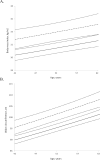Serial anthropometry predicts peripheral nerve dysfunction in a community cohort
- PMID: 23161607
- PMCID: PMC3565056
- DOI: 10.1002/dmrr.2367
Serial anthropometry predicts peripheral nerve dysfunction in a community cohort
Abstract
Background: Obesity is a risk factor for glucose intolerance, but the independent role of obesity in the development of peripheral neuropathy is unclear. This study assessed the impact of body size trajectories on prevalent nerve dysfunction in community-dwelling women with and without glucose intolerance.
Methods: Annual (1996-2008) anthropometric measures of weight, height, waist circumference and body mass index [BMI, weight (kg)/height (m(2) )] were assessed in the Study of Women's Health Across the Nation - Michigan site. Glucose intolerance was defined annually on the basis of current use of diabetes medications, self-reported diabetes diagnosis and, when available, fasting glucose. Peripheral nerve dysfunction in 2008 was defined as abnormal monofilament testing or ≥4 symptoms or signs. Linear mixed models were used to determine trajectories of anthropometry by subsequently identified nerve dysfunction status.
Results: Mean BMI was 32.4 kg/m(2) at baseline, and 27.8% of the women had nerve dysfunction in 2008. BMI, weight and waist circumference increased over time. Women who would have nerve dysfunction were significantly larger than women without dysfunction, independent of glucose intolerance. At mean baseline age of 46, BMI, weight and waist circumference differed significantly (p-value < 0.01) by subsequent nerve dysfunction status, independent of glucose intolerance and hypertension. These body size differences were maintained but not exacerbated over time.
Conclusions: Peripheral nerve dysfunction is prevalent among community-dwelling women. Twelve years before the nerve assessment, anthropometry differed between women who would and would not have nerve dysfunction, differences that were maintained over time. Obesity deserves attention as an important and potentially modifiable risk factor for peripheral nerve dysfunction.
Copyright © 2012 John Wiley & Sons, Ltd.
Figures


Similar articles
-
Monofilament insensitivity and small and large nerve fiber symptoms in impaired fasting glucose.Prim Care Diabetes. 2013 Dec;7(4):309-13. doi: 10.1016/j.pcd.2013.07.001. Epub 2013 Jul 27. Prim Care Diabetes. 2013. PMID: 23896181 Free PMC article.
-
Determining the best method for evaluating obesity and the risk for non-communicable diseases in women of childbearing age by measuring the body mass index, waist circumference, waist-to-hip ratio, waist-to-height ratio, A Body Shape Index, and hip index.Nutrition. 2023 Oct;114:112135. doi: 10.1016/j.nut.2023.112135. Epub 2023 Jun 16. Nutrition. 2023. PMID: 37453224
-
Body Composition Assessment and Nutritional Status Evaluation in Men and Women Portuguese Centenarians.J Nutr Health Aging. 2016 Mar;20(3):256-66. doi: 10.1007/s12603-015-0566-0. J Nutr Health Aging. 2016. PMID: 26892574
-
Cardiovascular autonomic dysfunction is associated with central obesity in persons with impaired glucose tolerance.Diabet Med. 2011 Jun;28(6):699-704. doi: 10.1111/j.1464-5491.2011.03278.x. Diabet Med. 2011. PMID: 21388444 Clinical Trial.
-
Anthropometric and adiposity indicators and risk of type 2 diabetes: systematic review and dose-response meta-analysis of cohort studies.BMJ. 2022 Jan 18;376:e067516. doi: 10.1136/bmj-2021-067516. BMJ. 2022. PMID: 35042741 Free PMC article.
Cited by
-
The association between perceived discrimination in midlife and peripheral neuropathy in a population-based cohort of women: the Study of Women's Health Across the Nation.Ann Epidemiol. 2019 Sep;37:10-16. doi: 10.1016/j.annepidem.2019.07.012. Epub 2019 Jul 27. Ann Epidemiol. 2019. PMID: 31447292 Free PMC article.
References
-
- Wang Y, Beydoun MA. The obesity epidemic in the United States—gender, age, socioeconomic, racial/ethnic, and geographic characteristics: a systematic review and meta-regression analysis. Epidemiol Rev. 2007;29:6–28. - PubMed
-
- U.S. Department of Health and Human Services . The Surgeon General's call to action to prevent and decrease overweight and obesity. U.S. Department of Health and Human Services, Public Health Service, Office of the Surgeon General; Rockville, MD: 2001. Available from: U.S. GPO, Washington. - PubMed
-
- Jia H, Lubetkin EI. Obesity-related quality-adjusted life years lost in the U.S. from 1993 to 2008. Am J Prev Med. 2010;39(3):220–7. - PubMed
-
- Vazquez G, Duval S, Jacobs DR, Silventoinen K. Comparison of body mass index, waist circumference, and waist/hip ratio in predicting incident diabetes: a meta-analysis. Epidemiol Rev. 2007;29:115–128. - PubMed
Publication types
MeSH terms
Grants and funding
- P30 DK092926/DK/NIDDK NIH HHS/United States
- R24 HD041028/HD/NICHD NIH HHS/United States
- AG012554/AG/NIA NIH HHS/United States
- AG012539/AG/NIA NIH HHS/United States
- P60 DK020572/DK/NIDDK NIH HHS/United States
- AG012531/AG/NIA NIH HHS/United States
- U01 AG012495/AG/NIA NIH HHS/United States
- AG012535/AG/NIA NIH HHS/United States
- AG012546/AG/NIA NIH HHS/United States
- AG017719/AG/NIA NIH HHS/United States
- AG012553/AG/NIA NIH HHS/United States
- NR004061/NR/NINR NIH HHS/United States
- U01 AG012554/AG/NIA NIH HHS/United States
- U01 AG012535/AG/NIA NIH HHS/United States
- U01 AG012553/AG/NIA NIH HHS/United States
- U01 NR004061/NR/NINR NIH HHS/United States
- U01 AG012539/AG/NIA NIH HHS/United States
- AG012495/AG/NIA NIH HHS/United States
- U01 AG012546/AG/NIA NIH HHS/United States
- P30DK092926/DK/NIDDK NIH HHS/United States
- P30 DK020572/DK/NIDDK NIH HHS/United States
- U01 AG012505/AG/NIA NIH HHS/United States
- P60DK020572/DK/NIDDK NIH HHS/United States
- U01 AG012531/AG/NIA NIH HHS/United States
- U01 AG017719/AG/NIA NIH HHS/United States
- AG012505/AG/NIA NIH HHS/United States
LinkOut - more resources
Full Text Sources
Other Literature Sources
Medical

